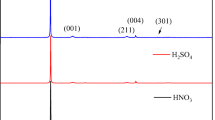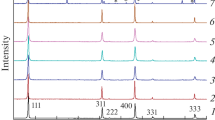Abstract
Graphitic anode materials for lithium ion batteries processed under high humidity conditions show severe performance losses. The sensitivity of these materials towards humidity can be significantly reduced by adsorbing metal ions like silver or copper ions, with subsequent heat treatment of these composites. Results of X-ray photoelectron spectroscopy, high-resolution electron microscopy, thermogravimetry, and differential thermal analysis indicate that the deposited metals exist in metallic and carbide, M x C (M=Cu or Ag), forms. They remove or cover (i.e. deactivate) active hydrophilic sites at the surface of the graphite. These composites absorb less water during processing. The electrochemical performance, including reversible capacity, coulombic efficiency in the first cycle, and cycling behavior, is markedly improved. This approach provides a potentially powerful method to manufacture lithium ion batteries under less demanding conditions.






Similar content being viewed by others
References
Besenhard JO (1999) Handbook of battery materials. Wiley-VCH, Weinheim
Wu YP, Wan C, Jiang C, Fang SB (2002) Principles, introduction and advances of lithium secondary batteries. Tsinghua University Press, Beijing
McCreery RL (1991) Carbon electrodes: structural effects on electron transfer kinetics. In: Bard AJ (ed) Electroanalytical chemistry, vol.17. Dekker, New York, p 221
Peled E, Menachem C, Bar-Tow D, Melman A (1996) J Electrochem Soc 143:L4
Wu YP, Wan C, Jiang C, Tsuchida E (2000) Electrochem Commun 2:272
Takamura T, Awano H, Ura T, Sumiya K (1997) J Power Sources 68:114
Ein-Eli Y, Koch VR (1997) J Electrochem Soc 144:2968
Wu YP, Jiang C, Wan C, Tsuchida E (2001) J Mater Chem 11:1233
Wu YP, Jiang C, Wan C, Holze R (2003) J Appl Electrochem (in press)
Menachem C, Wang Y, Floners J, Peled E, Greenbaum SG (1998) J Power Sources 76:180
Nakajima T, Yanagida K (1996) Tanso 174:195
Gaberscek M, Bele M, Drofenik J, Dominko R, Pejovnik S (2000) Electrochem Solid-State Lett 3:171
Saito M, Sumiya K, Sekine K, Takamura T (1999) Electrochemistry 67:957
Wang H, Yoshio M (2001) J Power Sources 101:35
Wu YP, Jiang C, Wan C, Tsuchida E (2000) Electrochem Commun 2:626
Barbooti M (1984) Sol Energy Mater 10:35
Vinkevisius J, Mozginsiene I, Jasulatiene V (1998) J Electroanal Chem 442:73
Wu Z, Pittman CU, Gardner SD (1995) Carbon 33:597
Zielke U, Huttinger KJ, Hoffman WP (1996) Carbon 34:983
Goethel PJ, Yang RT (1989) J Catal 119:201
Oh SG, Baker R (1991) J Catal 128:137
Pyun SI (1999) Fresenius J Anal Chem 363:38
Aurbach D, Ein-Eli Y, Chusid O, Carmeli Y, Babai M, Yamin H (1994) J Electrochem Soc 141:603
Debart A, Dupont L, Poizot P, Leriche JB, Tarascon J (2001) J Electrochem Soc 148:A1266
Whitehead A, Ellioft J, Owen J (1999) J Power Sources 81–82:33
Huang H, Kelder EM, Schoonman J (2001) J Power Sources 97–98:114
Grugeon S, Laruelle S, Herrera-Urbina R, Dupont L, Poizot P, Tarascon JM (2001) J Electrochem Soc 148:A285
Suzuki J, Yoshida M, Nakahara C, Sekine K, Kikuchi M, Takamura T (2001) Electrochem Solid-State Lett 4:A1
Momose H, Honbo H, Takeuchi S, Nishimura K, Horiba T, Muranaka Y, et al. (1997) J Power Sources 68:208
Nishimura K, Honbo H, Takeuchi S, Horiba T, Oda M, Koseki M, et al. (1997) J Power Sources 68:436
Yu P, Ritter JA, White RE, Popov BN (2000) J Electrochem Soc 147:1280
Kim S, Kadoma Y, Ikuta H, Uchimoto Y, Wakihara M (2001) Electrochem Solid-State Lett 4:A109
Dolle M, Grugeon S, Beaudoin B, Dupont L, Tarascon JM (2001) J Power Sources 97–98:104
Chung GC, Jun SH, Lee KY, Kim MH (1999) J Electrochem Soc 146:1664
Acknowledgements
Financial support from the China Postdoctor Foundation and the Alexander von Humboldt Foundation is appreciated.
Author information
Authors and Affiliations
Corresponding author
Additional information
Presented at the 3rd International Meeting on Advanced Batteries and Accumulators, 16–20 June 2002, Brno, Czech Republic
Rights and permissions
About this article
Cite this article
Holze, R., Wu, Y.P. Novel composite anode materials for lithium ion batteries with low sensitivity towards humidity. J Solid State Electrochem 8, 66–72 (2003). https://doi.org/10.1007/s10008-003-0398-4
Received:
Accepted:
Published:
Issue Date:
DOI: https://doi.org/10.1007/s10008-003-0398-4




